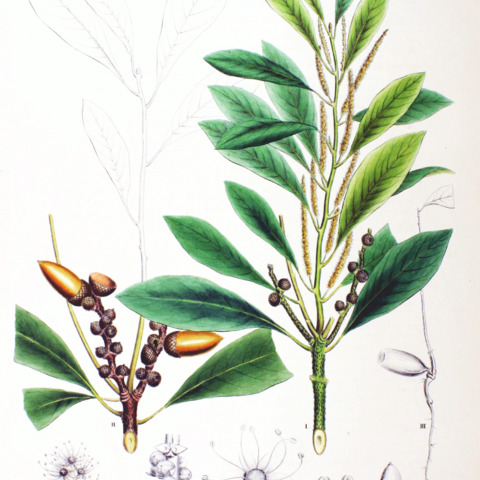Trees to 15 m tall; branchlets and rachis of inflorescences densely tawny tomentose. Petiole 1-2 cm, tomentose when young; leaf blade obovate, obovate-elliptic, or oblong, 6-12 × 2.5-5.5 cm, leathery to thickly papery, abaxially with dense scalelike glands and shortly tomentose when young, base cuneate, margin entire or with 2-4 teeth on apical part, apex abruptly acute, shortly acute, or long acuminate; secondary veins rarely over 10 on each side of midvein; tertiary veins abaxially usually not visible. Male inflorescences in a panicle or solitary in leaf axils, to 15 cm. Female inflorescences often with a few male flowers; cupules in clusters of 3(-5). Infructescences ca. 6 cm; rachis usually pubescent. Cupule plate-to cupular, 5-10 mm × 1-1.5 cm, enclosing 1/5-2/5 of nut, wall to 1.5 mm and woody near base; bracts imbricate or connate into concentric rings, triangular, small, appressed, densely puberulent. Nut ellipsoid, 1.2-2.5 × 0.8-1.5 cm, ± white glaucous, apex pointed, wall 0.5-1 mm thick; scar 3-5(-8) mm in diam., concave. Fl. Jul-Nov, fr. Jul-Nov of following year.
More
A tree. It grows to 15 m tall. The small branches have a light brown coating. The leaf stalk is 1-2 cm long. The leaf blade is oval and 6-12 cm long by 2.5-5.5. cm wide. It is leathery to thickly papery. It has dense scale like glands. The base is wedge shaped. There are 2-4 teeth near the tip. There are about 10 secondary veins each side of the main vein. The male flower can be in a cluster or singly. It is in the axils of leaves and is 10 cm long. The female flower often has a few male flowers. The nut is 1.2-2.5 cm long by 0.8-1.5 cm wide.


